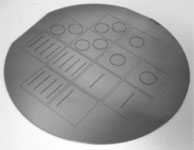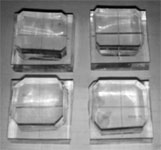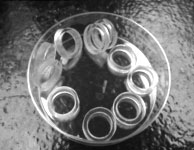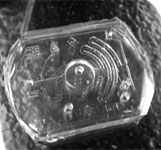Over the years, CBC Awards have funded numerous cutting-edge and unique research facilities at the three CBC universities. These resources and services were, and some still are available to Chicago area researchers. Scroll down or choose from the list:
- Advanced Imaging Core (AIC)
- BAC-Recombineering Core
- Center for Advanced Molecular Imaging (CAMI)
- Cellular Screening Center (CSC)
- Chicago Tri-Institutional Center for Chemical Methods and Library Development (CTCMLD)
- Computational Core
- Hitachi HD-2300A STEM
- Mass spectrometry Metabolomics and Proteomics Facility (MMPF)
- Microenvironmental Control Foundry
- Proteomics Center of Excellence (PCE)
Advanced Imaging Core (AIC)
Advanced Imaging Core (AIC) — a part of the Chicago Center for Systems Biology — collaborates with PIs, postdocs, and graduate students to provide a Digital Scanned Laser Light Sheet Fluorescence Microscope (DSML) from the European Molecular Biology Laboratory. The DSML is equipped with an objective for specimen illumination with multiple thin optical sheets. Another objective is used for data collection perpendicular to the illuminated plane. This technical approach reduces microscopy-related phototoxicity and photobleaching problems a hundred fold or more. Digital output is in the form of high-resolution images, available both as stills and movies. These scientific visualizations demonstrate dynamic physiological processes at molecular and cellular levels. For example, GFP- and YFP-tagged transcription factors or tagged histones can be used to study development of Drosophila, zebrafish, mice, and other kinds of organisms.
To further increase the resolution offered by AIC technologies, Stochastic Optical Reconstruction Microscopy (STORM) will become an imaging tool available for investigators soon.
AIC is led by Dr. Dmitri Novikov who works with Drosophila polytene chromosomes to study dynamic chromatin structures.
For more information, please, click here.
Location: Chicago Center for Systems Biology, (UChicago campus), 900 East 57th Street, Chicago, IL 60637
BAC-Recombineering Core
The BAC-Recombineering Core at the Chicago Center for Systems Biology provides investigators affiliated with CBC schools the capability to dynamically image fluorescently tagged proteins in model organisms and measure the spatiotemporal expression of the protein of interest. Such tagged proteins can be further used to purify their associated partners, and to identify their chromatin binding sites. The BAC construct contains the gene of interest in its native context, with associated regulatory elements and chromatin structure. A BAC transgene, therefore, typically expresses encoded genes at physiological levels similar to the endogenous gene.
For more information, please, click here.
Location: Chicago Center for Systems Biology, (UChicago campus), 900 East 57th Street, Chicago, IL 60637
Center for Advanced Molecular Imaging (CAMI)
The Center for Advanced Molecular Imaging is an imaging facility of unprecedented scope. It provides researchers with access to a wide variety of existing imaging modalities as well as new imaging technologies developed within the center. The facility is focused on providing multi-modal analysis of biological systems from the single cell to the whole animal.
State of the art cellular and molecular imaging services and training include the following modalities:
- Magnetic Resonance Imaging
- Optical Imaging
- Fluorescence and Bioluminescence Imaging
- Ultrasound Imaging (planned for future acquisition)
- Endoscopy (planned for future acquisition)
- Positron Emission Tomography (planned for future acquisition)
- Computed Tomography (planned for future acquisition)
- Single Photon Emission Computed Tomography (planned for future acquisition)
For more information, please, click here.
Location: Chemistry of Life Processes Institute, (NU-Evanston campus), 2170 Campus Dr., Evanston, IL 60208-2850
Cellular Screening Center (CSC)
The Cellular Screening Center (CSC) at the Institute for Genomics & Systmes Biology (IGSB) at the University of Chicago houses a state-of-the art high throughput cellular screening facility which opened in 2007. Support from the Chicago Biomedical Consortium and The University of Chicago Biological Sciences Division enabled the creation of the CSC. The CSC facilitates drug discovery and development by defining the complex genetics underlying disease, isolating chemical compounds that affect specific cellular activities, and developing potential therapeutics to target disease pathways. Automation is present for all aspects of the screening process. Without automation a 300 plate screen would take as long as 2 months. With the automation present in the CSC the same screen can be performed in as little as 2 days. CSC facilities are available to a broad network of Chicago area investigators on a collaborative basis established through internal and external funding. The Center has attracted a significant number of collaborations with area scientists in fields as diverse as cancer biology, diabetes and ophthalmology.
To learn more about IGSB’s Cellular Screening Center (CSC) click here.
Location: Chicago Center for Systems Biology, (UChicago campus), 900 East 57th Street, Chicago, IL 60637
Chicago Tri-Institutional Center for Chemical Methods and Library Development (CTCMLD)
The mission of the Chicago Tri-Institutional Center for Chemical Methods and Library Development (CTCMLD) is to address the fundamental challenges of modern high-throughput organic synthesis and to provide major advances that will significantly facilitate the development of small-molecule libraries for broad biological screening. Support from the CBC has strengthened the core infrastructure of the CTCMLD that contains three integral components, the Library Production Core located on the University of Chicago campus, the Hit-to-Lead Development Resource (HLR) located at Northwestern University and the Computational Cheminformatics Core at the University of Illinois at Chicago. CTCMLD offers a fully automated system for production of high-quality chemical libraries, cheminiformatics, analysis of biogenicity of lead compounds and the ability to further optimize their efficacy and pharmacological properties. Contact information regarding submission of collaborative proposals is located on CTCMLD website.
Location: Library Production Core, (UChicago campus), 5735 S. Ellis Avenue , Chicago, IL 60637
Hit-to-Lead Development Resource, (NU campus), 633 Clark Street, Crown Center Room 2-502, Evanston, IL 60208
Computational Cheminformatics Core, (UIC campus), 1737 W. Polk Street, Chicago, IL 60612
Computational Core
The Computational Core at the Chicago Center for Systems Biology (CCSB) is led by Dr. Robert Grossman, Director of Informatics at the Institute for Genomics & Systmes Biology (IGSB) at the University of Chicago. This Core relays on standard bioinformatics tools as well as specialized tools such as:
- Cistrack: Cistrack is a repository for transcriptional network studies.
- Flynet: Flynet provides an integrated view of Drosophila melanogaster transcription regulation and makes genome wide in vivo protein-DNA interactions data available to the scientific community as a whole.
- The Chicago Utility for Biological Sciences (CUBioS): The CBC/CUBioS project is an open-source cloud-based bioinformatics platform. Cistrack is CUBioS instance. CUBioS is available from Source Forge and can be customized to support a variety of bioinformatics applications.
- Bionimbus: a cloud-based system for managing, analyzing and sharing genomic data.
- Sector/Sphere: a cloud-based system for data intensive computing.
For more information, please, click here.
Location: Chicago Center for Systems Biology, (UChicago campus), 900 East 57th Street, Chicago, IL 60637
Hitachi HD-2300A STEM
A fully equipped atomic resolution analytical STEM (Scanning Transmission Electron Microscope) with a high-brightness cold cathode field emission gun that can be operated at 200, 120, or at 80kV.
This instrument provides detectors for 3 different modes of imaging: 1. SE mode uses secondary electrons for visualization of sample surface, 2. TE mode uses transmitted electrons for imaging of thin samples with contrast based on electron density, and 3. ZC (Z-contrast) mode for imaging of thin samples with contrast based on the elemental composition (Z = atomic number) of the specimens.
With the attached cryo-transfer system and –holder, both, cryo-SE and cryo-STEM investigation can be performed at liquid-N2 temperature, under low-dose mode.
The device also offers advanced microanalytical capabilities with dual EDS detectors for X-ray energy dispersive spectroscopy (EDS) analysis, and for electron energy-loss spectroscopy (EELS) with a Gatan Enfina EELS spectrometer.
With its comprehensive imaging and microanalytical capabilities, the HD 2300A is a versatile tool for studies of biological samples as well as for research in materials science.
The unit forms the centerpiece of the TEM section of the Electron Probe Instrumentation Center (EPIC). EPIC is part of the NUANCE Center (Atomic – and Nanoscale Characterization Experimental Center) at Northwestern University.
For more information about Hitachi HD-2300A STEM, please, click here.
Location: NUANCE, (NU-Evanston campus), 2220 Campus Drive #2036, Evanston, IL 60208-3108
Mass spectrometry Metabolomics and Proteomics Facility (MMPF)
Mass spectrometry Metabolomics and Proteomics Facility (MMPF; formerly known as The Proteomics and Informatics Services Facility or PISF) is located on the University of Illinois at Chicago (UIC) campus. Through the facility, investigators affiliated with CBC member institutions have access to a number of mass spectrometers optimized for use in proteomics studies. Please visit the facility’s website to learn more.
Location: Mass spectrometry Metabolomics and Proteomics Facility (MMPF), (UIC campus), University of Illinois at Chicago, 835 S. Wolcott Ave., MSB Room E-125, Chicago, IL 60612
Microenvironmental Control Foundry
The Microenvironmental Control Foundry was funded through the CBC Lever Award: Nanomaterials for Cancer Diagnostics and Therapeutics. Located at UIC, the foundry will fabricate custom microfluidic devices, microfluidic oxygenation control devices, and molds for micropatterning substrates to researchers at the CBC universities (NU, UChicago, or UIC). The foundry has a Heidelberg uPG101 maskless lithography system to facilitate rapid turn around of designs and devices. The devices will be provided at no cost and foundry staff will provide training to users of these new technologies.
The goal of the foundry is to disseminate microfluidic tools to researchers by either reproducing devices reported in the literature or by working with the foundry staff to develop new devices for specific applications. Microfludic devices leverage beneficial phenomena found at the microscale such as process integration, fast diffusion, or high surface to volume ratios to precisely control the microscale and allow new experiments not possible with standard techniques. While there are many applications in the biomedical sciences, the scope of the work does not need to be limited to this area, and the foundry is prepared to develop devices for other application.
David Eddington is the Director of the Foundry. Dr. Eddington has expertise in developing simple microfluidic systems that can be integrated into standard biomedical research assays. Currently, the foundry employs two Application Engineers: Dr. Joe Lo and Dr. Shawn Oppegard.
For more information please visit the foundry’s website. Reserchers interested in microfluidic devices can contact David Eddington by email at: dte@uic.edu or by phone at: 312-355-3278.




From the left: SU8 mold for micropatterning, microfluidic devices for flow focusing and separations, gaskets for topical application of agents to animal models, and microfluidic device for islet analysis. Images: Courtesy of David Eddington.
Location: Microenvironmental Control Foundry, (UIC campus), University of Illinois at Chicago, Science and Engineering Labs, Room 2025, 950 S. Halsted St, Chicago IL, 60607
Proteomics Center of Excellence (PCE)
The Proteomics Center of Excellence’s (PCE) mission is two-fold; first, to utilize high performance technology for mass spectrometry-based proteomics and second, the development of next-generation technology for Top Down proteomics. The Center is located on the Northwestern University-Evanston Campus and offers:
Top Down Proteomics
The Proteomics Center houses the best technologies for “Top Down” proteomics, and pushes the limits for analysis of whole protein molecules. Intact protein analysis allows for complete sequence coverage and retention of post-translational modifications.
Precision Bottom Up Proteomics
The Center implements known technologies for “Bottom Up”, but emphasizes the philosophy of ‘precision proteomics’, which uses high performance mass spectrometry to deliver protein identifications with very high confidence and in a gene-specific fashion. Quantitation of protein expression and confident assignment of post-translational modifications is made possible in a highly collaborative framework.
Quantitative Proteomics
With the triple-quadrupole mass spectrometer, the Center can provide quantitative site-specific information about methylations and acetylations on histones.
The PCE continues to strive to educate the scientific community on the benefits of Top Down proteomics as an analysis tool. If you are interested in learning more about the analysis of intact proteins please visit www.topdownproteomics.org.
For more information about PCE, please, click here.
Location: Proteomic Center of Excellence (PCE), (NU-Evanston campus), Silverman Hall B550, 2170 Campus Dr., Evanston, IL 60208
